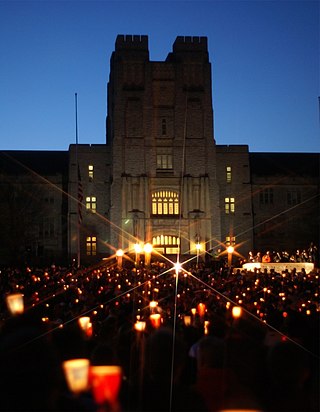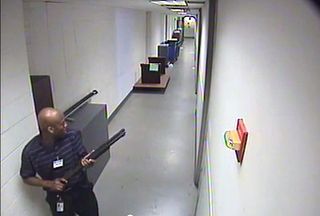
A school shooting is an armed attack at an educational institution, such as a primary school, secondary school, high school or university, involving the use of a firearm. Many school shootings are also categorized as mass shootings due to multiple casualties. The phenomenon is most widespread in the United States, which has the highest number of school-related shootings, although school shootings have taken place elsewhere in the world.
Gun laws in Australia are predominantly within the jurisdiction of Australian states and territories, with the importation of guns regulated by the federal government. In the last two decades of the 20th century, following several high-profile killing sprees, the federal government coordinated more restrictive firearms legislation with all state governments.
The 101 California Street Shooting was a mass shooting on July 1, 1993, in San Francisco, California. The killings sparked a number of legal and legislative actions that were precursors to the Violent Crime Control and Law Enforcement Act, H.R. 3355, 103rd Congress. The Act took effect in 1994 and expired in September 2004 after the expiration of a sunset provision. At the time, the incident was the deadliest mass shooting in the Bay Area's history, being surpassed 28 years later by the 2021 San Jose shooting.

Monash University, Clayton campus is the main campus of Monash University located in Clayton, which is a suburb of Melbourne, Australia, in the state of Victoria.
On January 16, 2002, a school shooting occurred at the Appalachian School of Law, an American Bar Association accredited private law school in Grundy, Virginia, United States. Three people were killed, and three others were wounded when a former student, 43-year-old Nigerian immigrant Peter Odighizuwa, opened fire in the school with a handgun.

The Virginia Tech shooting was a spree shooting that occurred on Monday, April 16, 2007, comprising two attacks on the campus of the Virginia Polytechnic Institute and State University in Blacksburg, Virginia, United States. Seung-Hui Cho, an undergraduate student at the university, killed 32 people and wounded 17 others with two semi-automatic pistols. Six others were injured jumping out of windows to escape Cho.

Seung-Hui Cho was a South Korean mass murderer responsible for the Virginia Tech shooting in 2007. Cho killed 32 people and wounded 17 others with two semi-automatic pistols on April 16, 2007, at Virginia Tech in Blacksburg, Virginia. This killing is the deadliest school shooting in U.S. history, and was at the time the deadliest mass shooting in U.S. history. A senior-level undergraduate student at the university, Cho died by suicide after police breached the doors of Virginia Tech's Norris Hall which Cho had locked with heavy chains, where most of the shooting had taken place.
Monash University is an Australian university located in Melbourne, Australia with some international campuses. It was established by an Act of the State Parliament of Victoria in 1958 as a result of the Murray Report which was commissioned in 1957 by the then Prime Minister Sir Robert Menzies to establish the second university in the state of Victoria.

A mass shooting is a violent crime in which one or more attackers kill or injure multiple individuals simultaneously using a firearm. There is no widely accepted definition of "mass shooting" and different organizations tracking such incidents use different definitions. Definitions of mass shootings exclude warfare and sometimes exclude instances of gang violence, armed robberies, familicides and terrorism. The perpetrator of an ongoing mass shooting may be referred to as an active shooter.
On August 7, 2011, a mass shooting occurred in Copley Township, Ohio, committed by 51-year-old Michael E. Hance. Seven people were shot dead before the gunman was shot and killed by Copley police officer Ben Campbell. Hance had previously displayed erratic and bizarre behavior, and was considered by those who knew him to be delusional. Campbell later received the Law Enforcement Congressional Badge of Bravery for taking down Hance.

The Umpqua Community College shooting occurred on October 1, 2015, at the UCC campus near Roseburg, Oregon, United States. Chris Harper-Mercer, a 26-year-old student who was enrolled at the school, fatally shot an assistant professor and eight students in a classroom, and injured eight others. Roseburg police detectives responded to the incident and engaged Harper-Mercer in a brief shootout. After being wounded, he committed suicide by shooting himself in the head. The mass shooting is the deadliest in Oregon's modern history.
The National Firearms Agreement (NFA), also sometimes called the National Agreement on Firearms, the National Firearms Agreement and Buyback Program, or the Nationwide Agreement on Firearms, was an agreement concerning firearm control made by Australasian Police Ministers' Council (APMC) in 1996, in response to the Port Arthur massacre that killed 35 people. Four days after the killings, Australian Prime Minister John Howard told Parliament “We need to achieve a total prohibition on the ownership, possession, sale and importation of all automatic and semi-automatic weapons. That will be the essence of the proposal that will be put by the Commonwealth government at the meeting on Friday...". The laws to give effect to the Agreement were passed by Australian State governments only 12 days after the Port Arthur massacre.

On October 1, 2017, a mass shooting occurred when 64-year-old Stephen Paddock opened fire on the crowd attending the Route 91 Harvest music festival on the Las Vegas Strip in Nevada from his 32nd-floor suites in the Mandalay Bay hotel. He fired more than 1,000 rounds, killing 60 people and wounding at least 413. The ensuing panic brought the total number of injured to approximately 867. About an hour later, he was found dead in his room from a self-inflicted gunshot wound. The motive for the shooting is officially undetermined.

Stephen Craig Paddock was an American mass murderer who perpetrated the 2017 Las Vegas shooting. Paddock opened fire into a crowd of about 22,000 concertgoers attending a country music festival on the Las Vegas Strip, killing 60 people and injuring approximately 867. Paddock killed himself in his hotel room following the shooting. The incident is the deadliest mass shooting by a lone shooter in United States history. Paddock's motive remains officially undetermined, and the possible factors are the subject of speculation.
The Marshall County High School shooting was a mass shooting that occurred at Marshall County High School near Benton, Kentucky, on January 23, 2018. The gunman, 15-year-old student Gabe Parker, opened fire in an open area at the school, murdering two students and injuring 14 others.
Criminal activity in Victoria, Australia is combated by the Victoria Police and the Victorian court system, while statistics about crime are managed by the Crime Statistics Agency. Modern Australian states and cities, including Victoria, have some of the lowest crime rates recorded globally with Australia ranked the 13th safest nation and Melbourne ranked the 5th safest city globally. As of September 2018 the CBD of Melbourne had the highest rate of overall criminal incidents in the state (15,949.9), followed by Latrobe (12,896.1) and Yarra (11,119.2). Rural areas have comparatively high crime rates, with towns such as Mildura (9,222.0) and Greater Shepparton (9,111.8) having some of the highest crime rates in the state.

The Christchurch mosque shootings were two consecutive mass shootings on two mosques in Christchurch, New Zealand on 15 March 2019. They were committed by Brenton Tarrant who entered both mosques during Friday prayer, firstly at the Al Noor Mosque at 1:40 p.m. and later at the Linwood Islamic Centre at 1:52 p.m.

On April 30, 2019, a mass shooting occurred at the University of North Carolina at Charlotte. The shooting, which occurred on the last day of classes for the spring semester, sent six people to the hospital, two of whom were dead upon arrival, and left three others in critical condition. The shooting occurred inside a classroom in the Woodford A. Kennedy Building while students were giving a final presentation. The perpetrator, a former UNCC student named Trystan Andrew Terrell, was arrested shortly afterwards. In September 2019, he pleaded guilty to the murders and was sentenced to life imprisonment without the possibility of parole.










